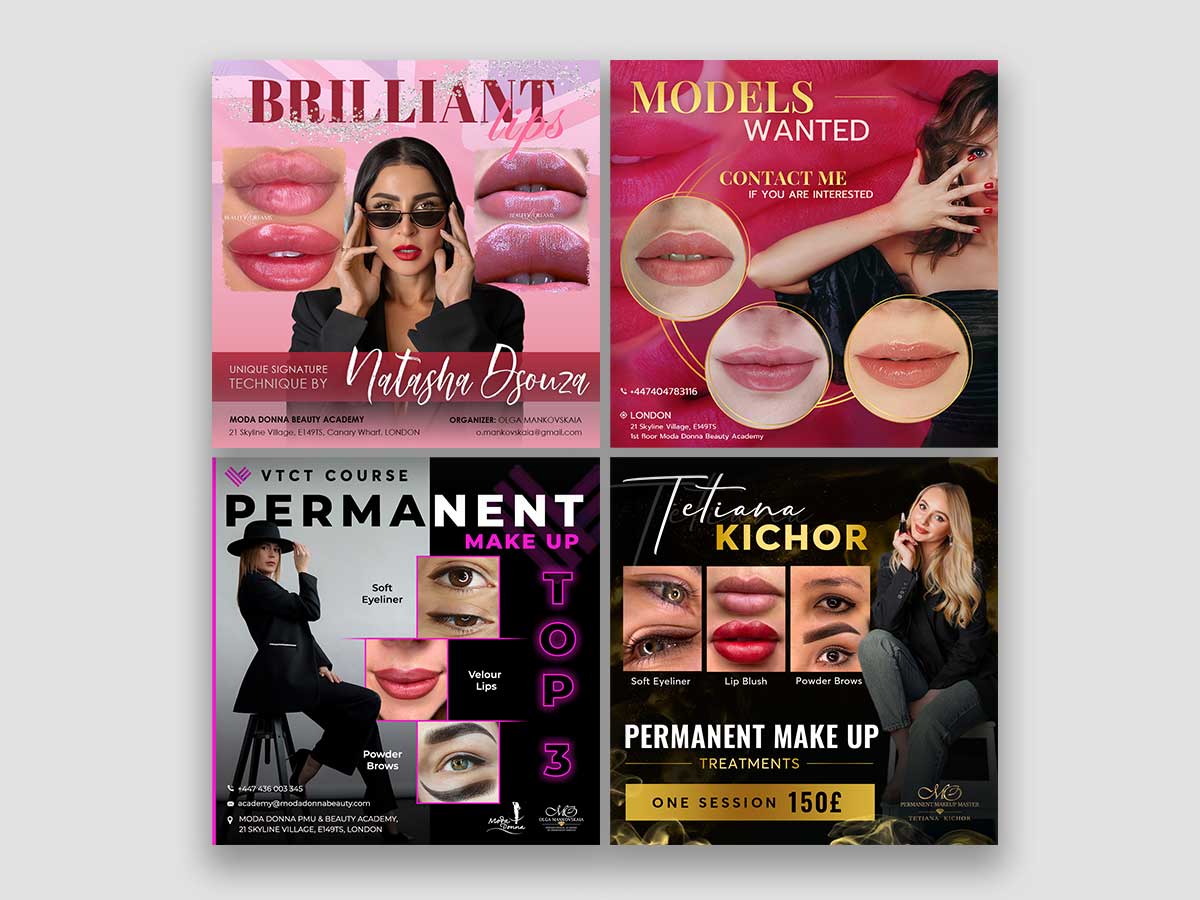The permanent makeup (PMU) industry is booming—and with that comes competition that can feel overwhelming. Whether you’re just starting out or you’ve been perfecting brows and lips for years, one thing’s certain: your portfolio is your strongest marketing weapon. It’s not just a collection of before-and-after photos. It’s the story of your artistry, professionalism, and growth.
But how do you create a portfolio that doesn’t just look good but genuinely makes potential clients stop scrolling and think, Wow, I need to book with this artist? Let’s break it down.
Contents
- 1 Why Your Portfolio is Your “Silent Salesperson”
- 2 Curating Your Best Work (Not All Your Work)
- 3 The Magic of Before-and-After Photos
- 4 Adding Videos for an Extra Edge
- 5 Editing Without Overdoing It
- 6 Building a Digital Portfolio
- 7 Don’t Forget Captions and Context
- 8 Include Healing Stages
- 9 The Power of Client Testimonials
- 10 Keep It Fresh
- 11 Common Mistakes That Can Tank Your Portfolio
- 12 Your Portfolio is More Than Just PMU
- 13 Growing Your Portfolio as a Beginner
- 14 Packaging Your Portfolio for Different Platforms
- 15 Is It Worth Hiring a Photographer?
- 16 Wrapping It All Up
Why Your Portfolio is Your “Silent Salesperson”
Think of your portfolio as your most persuasive employee—the one who’s always working while you sleep, convincing people you’re the right PMU artist for them. Unlike a quick conversation or an ad, your portfolio gives a full, unfiltered glimpse into your skill level, your attention to detail, and your unique style.
People rarely gamble when it comes to their faces. They want proof. A client who sees crisp, balanced hairstrokes or perfectly shaded lips will book faster than someone who only reads a price list. Honestly, your portfolio is often the difference between a “maybe” and a “yes.”
Curating Your Best Work (Not All Your Work)
Here’s the thing: your portfolio isn’t a storage unit for every photo you’ve ever taken. It’s more like a gallery where only your standout pieces deserve to be displayed. Even if you’re still new, you probably have a few treatments that make you proud—those go in first.
Don’t be tempted to show “variety” by including work that doesn’t meet your highest standard. A single blurry or uneven brow photo can quietly raise doubts. Aim for quality over quantity.
A good starting point?
-
Showcase 10-15 of your strongest examples.
-
Include a mix of brows, lips, and eyeliner (if you do all three).
-
Use only high-resolution, clear images—no harsh filters.
The Magic of Before-and-After Photos
Before-and-after photos are a PMU portfolio staple for a reason. They tell a story—a visual transformation that speaks louder than any caption.
But here’s a pro tip: consistency is everything. Use the same lighting and angles for both shots. Clients want to see the results, not be distracted by a shadowy “before” and a sunlit “after.”
Ring lights are a game-changer here. If you don’t own one yet, consider investing—it’s one of the simplest ways to make your photos look professional.
Adding Videos for an Extra Edge
Photos are great, but short videos (like Instagram Reels or TikToks) can bring your work to life. A 10-second clip showing how crisp your hairstrokes look up close or how natural your shading is under different lighting can make a bigger impact than a static image.
You don’t need a fancy camera. A modern smartphone and a steady hand—or even a cheap tripod—can give you professional-looking content.
Editing Without Overdoing It
We’ve all seen over-edited photos where the skin looks blurred to the point of resembling plastic. Don’t go there. Clients are savvier than ever; they can spot over-filtered work, and it can make them question what’s real.
If you want to make slight tweaks, stick to:
-
Brightening the photo
-
Adjusting contrast or sharpness
-
Cropping distractions out
Your goal is to showcase real results. If a client books based on a polished photo but gets a different outcome in real life, that’s a recipe for bad reviews—and word travels fast in the beauty industry.
Building a Digital Portfolio
While a physical portfolio (like a printed photo album) can be a nice touch for studio walk-ins, your digital presence is what truly matters now.
-
Instagram: Still the go-to platform for PMU artists. Use your grid like a curated gallery, and your Stories or Highlights for behind-the-scenes content.
-
Website: Having a professional website can set you apart instantly. Use it to showcase a “Portfolio” page with your best work, reviews, and booking information. Tools like WordPress or Squarespace make it surprisingly easy.
-
Google Business Profile: Clients often Google before they book. Upload a selection of your top images there too—it boosts your credibility and SEO.
Don’t Forget Captions and Context
A strong portfolio isn’t just about visuals—it’s also about telling the story behind the work. Instead of posting a bare photo of brows, add context like:
“These powder brows healed beautifully after 6 weeks! My client wanted a soft, natural look that complements her skin tone.”
It’s subtle, but captions like this show you understand your craft and client needs.
Include Healing Stages
This is one detail many artists skip, but it’s so powerful. New clients often panic when they see their fresh brows looking too dark or swollen. Showing a series of photos—freshly done, healed after 4 weeks, and maybe a quick after-touch-up—educates them on what to expect and builds trust.
The Power of Client Testimonials
Your work speaks for itself, but hearing a real client gush about how confident they feel after your treatment? That’s priceless.
You can sprinkle short testimonials between your photos or create a dedicated “Reviews” highlight on Instagram. A quick, authentic review—maybe even a 20-second video clip of a happy client—is worth more than any ad spend.
Keep It Fresh
A stale portfolio gives the impression that you’re not active or evolving. Set a reminder to update your portfolio every month or two. Swap out older work with fresher, sharper examples as your technique improves.
Common Mistakes That Can Tank Your Portfolio
Let’s be real—there are a few things that can instantly turn clients off:
-
Overusing filters (we’ve already talked about this).
-
Posting messy, cluttered photos with background distractions.
-
Not showing healed results.
-
Having inconsistent styles—if your brows look natural in one post but blocky in the next, it confuses people.
Your Portfolio is More Than Just PMU
Here’s a little secret: your portfolio isn’t only about brows or lips. It’s also about you. People choose artists they feel connected to. Don’t be afraid to sprinkle in a few shots of your studio, your tools, or even a candid photo of you at work.
It creates a sense of personality and professionalism. Clients want to see the human behind the needle.
Growing Your Portfolio as a Beginner
If you’re new and worried about not having enough “wow” work yet, don’t stress. Start by offering discounted treatments to a few models in exchange for permission to take photos. Document every stage of your growth.
Clients love seeing honesty. Even posting “I’m working on perfecting my technique” alongside good photos can resonate more than trying to look flawless from day one.
Packaging Your Portfolio for Different Platforms
You might be surprised, but what works on Instagram might not work on your website. Instagram thrives on quick, scrollable visuals, while a website needs a cleaner, more organized approach.
For Instagram:
-
Use carousel posts (before and after in one swipe).
-
Mix grid-worthy photos with casual, behind-the-scenes Stories.
For Your Website:
-
Create separate galleries for brows, lips, eyeliner.
-
Keep navigation simple—don’t make visitors hunt for your work.
Is It Worth Hiring a Photographer?
You know what? If you can swing it, yes. A professional photographer can take your portfolio from “good” to “luxury-level” instantly. Even one session can give you 20-30 polished photos to use for months.
If that’s not in the budget yet, learn a few photography basics. Natural daylight, a clean backdrop, and steady angles can make a huge difference.
Wrapping It All Up
Creating a winning PMU portfolio isn’t a one-time project—it’s an ongoing reflection of your skill, care, and personality. Think of it as your living, breathing business card that never stops working for you.
When done right, your portfolio doesn’t just showcase your work. It shows potential clients why you are the artist they can trust to handle something as personal as their face.
Final Thought
Your portfolio is your voice in a crowded industry. Make it honest, make it beautiful, and keep it evolving as you do. Because when someone’s scrolling through endless PMU profiles, yours should be the one that makes them stop and think, This is the artist I’ve been looking for.

